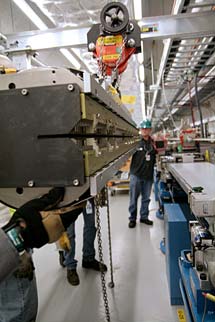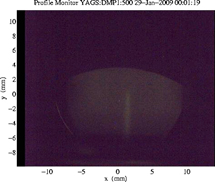
Handy Links
SLAC News Center
SLAC Today
- Subscribe
- Archives: Feb 2006-May 20, 2011
- Archives: May 23, 2011 and later
- Submit Feedback or Story Ideas
- About SLAC Today
SLAC News
Lab News
- Interactions
- Lightsources.org
- ILC NewsLine
- Int'l Science Grid This Week
- Fermilab Today
- Berkeley Lab News
- @brookhaven TODAY
- DOE Pulse
- CERN Courier
- DESY inForm
- US / LHC
SLAC Links
- Emergency
- Safety
- Policy Repository
- Site Entry Form

- Site Maps
- M & O Review
- Computing Status & Calendar
- SLAC Colloquium
- SLACspeak
- SLACspace
- SLAC Logo
- Café Menu
- Flea Market
- Web E-mail
- Marguerite Shuttle
- Discount Commuter Passes
-
Award Reporting Form
- SPIRES
- SciDoc
- Activity Groups
- Library
Stanford
Around the Bay
First Undulator Test Lights Up the LCLS
The Linac Coherent Light Source reached another milestone last Wednesday evening, when a beam of electrons wiggled its way through a row of magnets and produced the instrument's first X-rays.
Electrons first traversed the length of the LCLS in December, but until now there were no X-rays. "This is the first time we actually had an electron beam going through an undulator," said SLAC physicist Heinz-Dieter Nuhn, who has been with the project since 1991. "It's pretty exciting."
The X-rays' saga began early Wednesday morning, when SLAC maintenance and construction crews mounted an 1800-pound series of magnets called an undulator to a girder about two-thirds of the way down the Undulator Hall.
Before the crew could put the undulator on the girder, they had to make sure every piece of the girder was in the right spot. They took precise measurements of each component's position using a laser. This is normally a quick process, said Hans Imfeld, a survey engineer, but this time the team took extra care. They wanted to see if the weight of the undulator makes the girder move.
When they were confident that everything was in place, the crew hoisted the undulator into the air with a system of pulleys and delicately rested the nearly four-yard-long cylinder on two thick metal plates. These plates slide in and out under remote control to move the undulator over the vacuum chamber that holds the electron beam, allowing physicists to control whether or not the chamber is filled with a magnetic field.
Finally, hours later, a beam of electrons raced down the linac and through the undulator, making 112 tiny zig-zags under the influence of its magnetic field. This movement generated X-rays, which sped along the tunnel with the electrons, spreading out ever so slightly in a lopsided cone of light.
After a magnet diverted the electrons into the beam dump, the X-rays continued onward, ultimately striking an inch-wide circular screen of yttrium-aluminum-garnet. This semi-precious stone serves as a temporary (and "simple-minded," Nuhn added) X-ray detector. It absorbed the X-ray energy and converted it to visible light, glowing faintly. The glow was recorded by a camera and relayed to the control room, where Nuhn and his colleagues could see it. The team expects to install more sophisticated X-ray detectors by May, including a monochrometer and a calorimeter to measure the X-rays' wavelength and intensity.
The undulator will stay in place until March 2, when it will be swapped out in favor of 18 new ones. This particular undulator will then be tested for radiation damage—interacting with the radiation produced by electrons hitting the vacuum chamber or other elements could demagnetize it, Nuhn said. "We hope for no damage at all, but we just want to check."
They will also test how the undulator affects the steering of the electron beam—how much the beam deviates from its original path. The team will tolerate almost no error here; ultimately the electron beam will need to follow a straight line with a precision of one ten-thousandth of an inch. "Each undulator needs to keep the beam where it found it," Nuhn said. "Even small bumps to the beam's path can lead to a reduction in laser output."
Nuhn was pleased to see evidence of the X-rays, but he wasn't surprised. He knew it was going to work. "There's no mystery," he said. "It's not the final goal of the LCLS yet. But it's a nice milestone to have come this far."
—Lisa Grossman
SLAC Today, February 3, 2009

